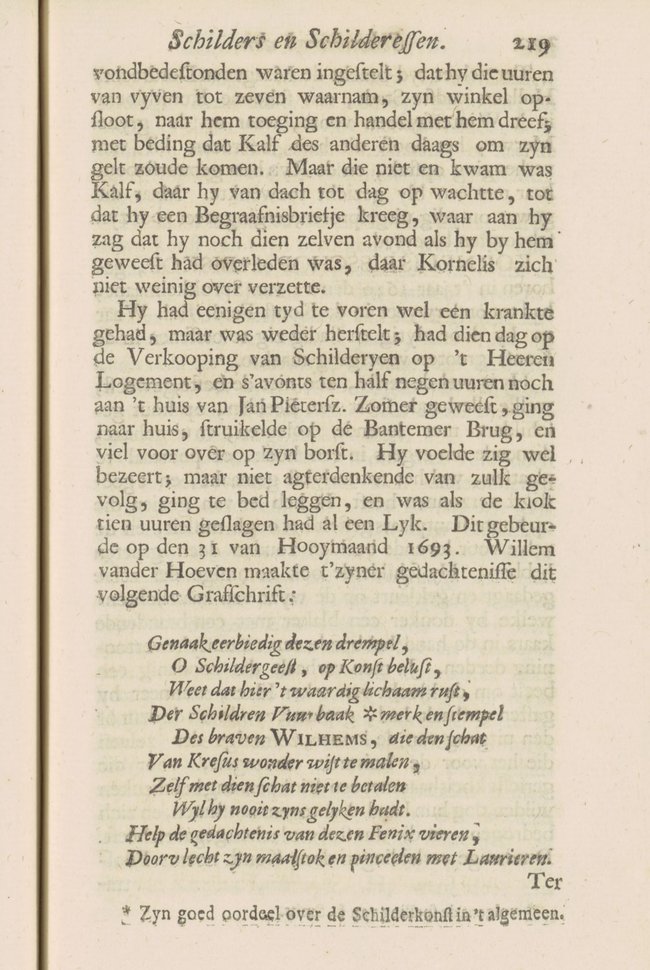Volume 2, page 210-219
Page 210
so that that art is now dying. He is currently a man of 75 years.
VINCENT LAURENSZ. van der VINNE I was born in Haarlem in the year 1629. Inclined to art from a young age, he drew and painted after prints or drawings so loosely and wittily that it was clear enough that nature favoured him and as a consequence he was born for this practice. This love of art increased with the years, all the more when he daily associated with the sons of Frans Hals, who lived in his neighbourhood, which induced his parents to have him learn art with the mentioned Frans Hals, where he improved so much in a few years, and mastered Hals' bold handling, that he believed his wings had grown long enough to undertake a flight. He then went to Germany, Switzerland and France, where he found opportunity everywhere to practice his art. He returned to his native city in the year 1655, where he was welcomed by all lovers of art and made himself especially liked by his cheerful nature and poetry.
In the meantime he painted everything that came his way, rooms, attics, signs, it was so indifferent to him that one could not say what part of art he preferred as his subject. But one could say that he followed nature in landscapes, buildings, still life, animals, birds, farmers and histories of large or small size. In addition he was fortunate in the capturing of likenesses, which he touched with a bold brush after the example of his master Frans Hals, who was wont to say
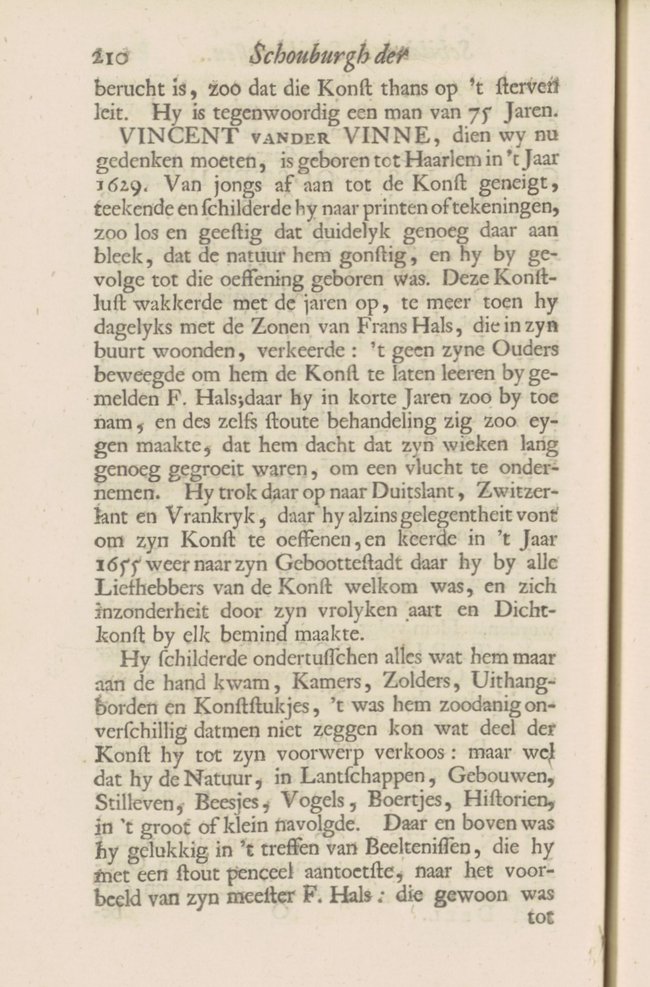
Page 211
to his students: You must smear boldly. When you become accomplished in art the precision will follow on its own.
With that bold way of painting he was able to display handily and, seen from a small distance, handsomely. And since he usually applied himself to what would be most profitable, one saw in his time the stores in Haarlem displaying nicely painted signs more than in other cities, so that the comical Job Berckheyde was wont to say: Van der Vinne is the Raphael of sign painting.
Meanwhile he did not cease to practice his art in other ways and to show his intellect with clever finds in allegories and speaking portraits (as Hendrick Goltzius, Maarten van Heemskerck and Romeyn de Hooghe have done). Now we would also like to commemorate an example or two of the farcical acts of his green years which prove how, when they got him into trouble, he was able to make timely use his intellect.
His travelling companions who accompanied him from Haarlem to Germany were Cornelis Bega, Dirck Helmbreeker and Guillam Du Bois, but they did not all remain with him, but one after another slunk back home after they had attended some inventive confrontation (for our Van der Vinne tended to pranks). In Yverdon-les-Bains, in Switzerland, he made a kite, doubly covered, and garnished with lights within, and let it go up in the night in a good breeze. This roused the farmers, by no means the brightest lot, who each observed this with amazement so that
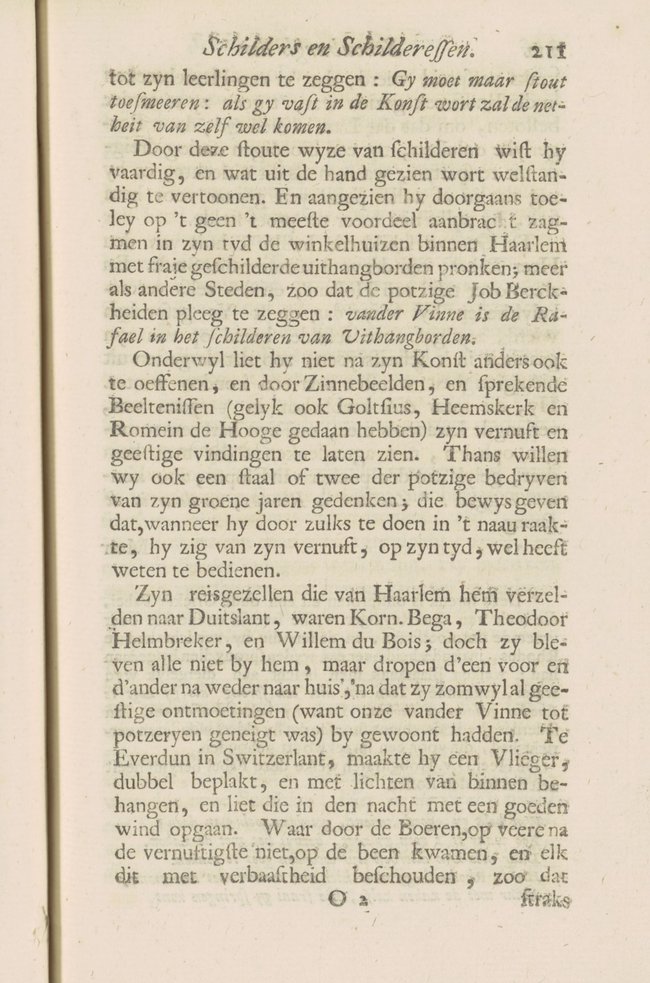
Page 212
it was at once spread about that an omen had been seen in that region, which they were all the more ready to conclude because that land was threatening to break out in bloody warfare due to civil unrest. That is why when this came out and he saw that such pranks could pose a danger to himself, he ceased to put them to the test.
In Geneva he painted in the house of Mister Rozet [= Marc Roset], one of the most distinguished men of that city. And whenever the table talk turned to Holland and its amusements on winter days on the ice, our painter made a great deal of his speed in skating, so that out of curiosity the guests wished for a cold winter. He, who was only a clumsy skater, pretended to pine along with them, to be able to live himself out once more, not reflecting that people would be able to say, as to Aesop's boaster: See, here is Rhodes, and there is the leap.*
--------
* This saying originated with an old Greek fable which mentions a traveller who blabbered and bragged about strange meetings and deeds that he had carried out in Rhodes, and especially about a wide jump that he had made. They brought this boaster to such a wide water, saying: Show us here a jump such as you claim to have done in Rhodes. Which ended badly for him. And since that time when someone boasted that he had peformed miracles elsewhere, this was held as a proverb.
Mister David van Hoogstraten, who put this fable to rhyme, said this to the braggard.
What witnesses, good friend, do you have of this act?
In truth prove what you say with the deed.
That way your words are best demonstrated.
Here is Rhodes; you must not show it here with the mouth,
But with the case itself, how well you can jump.
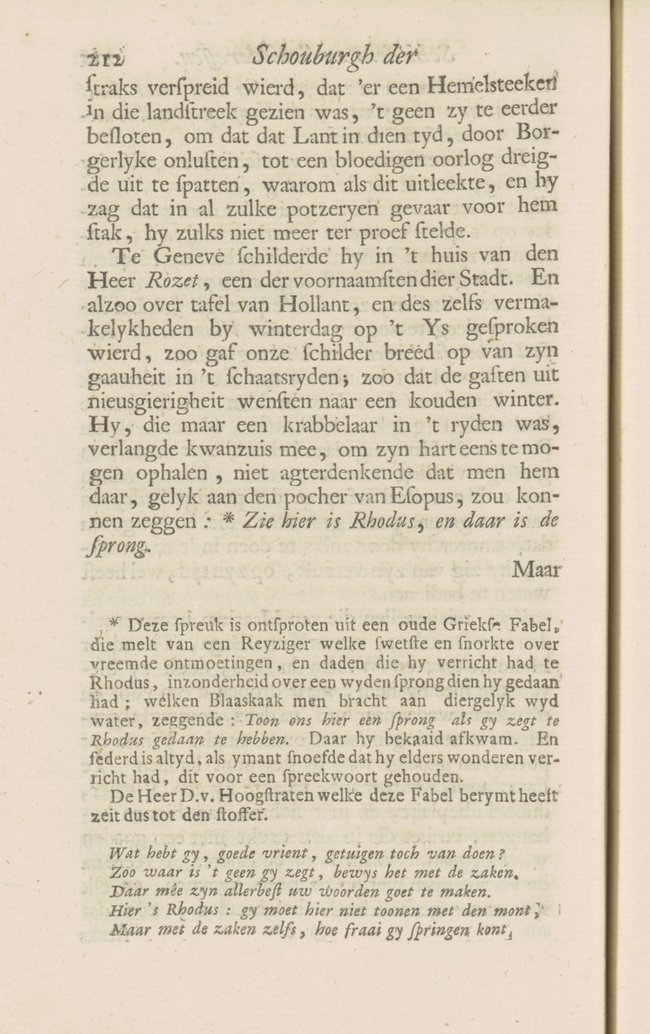
Page 213
But like those who in the winter brag about swimming and in the summer about skating, he too believed that he was in no danger of being put to the test.
It happened, however, that in the winter of the year 1653 it became so bitterly cold that the water, even of the nearby Lac or Lake, became covered with ice strong enough to be able to support a human being. Then the gentleman and all the family urged him to show his art. His first excuse was that he had no skates, but these were put at his disposal by a merchant's son, who had lived in Holland. Now he was really in a bind. What excuse now? For the show was to take place the next day, and the gentleman had already invited several upstanding people for the spectacle.
Now a ruse had to be invented so as not to make mock of these people, who would regard him as a boaster or a windbag. At night he thought up a ruse that would not be suspected and put it into practice in the morning. He cut a hole in his shoe and appeared cripple and limping. When he was asked, Master what is wrong with your foot? His answer was: ag! I have stubbed it so badly, that I can neither stand nor move. When he was then asked: well, will you be able to skate then? Impossible, was the answer. Mister Roset, sorely put on the spot by this, said, what counsel now? I have already invited my friends, and the time has come. I know what, answered our painter. Here in the city lives a shoemaker's apprentice from Haarlem, named Joost Baile, who is eminently capable on skates, let him be fetched in my name. The latter was at once
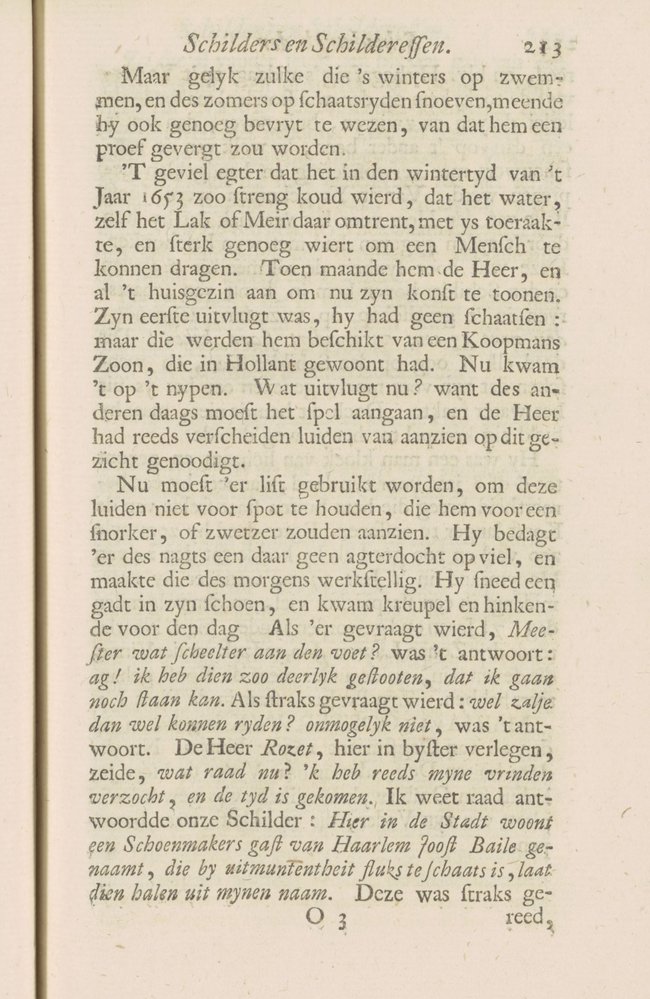
Page 214
ready and happy. He went on the ice in the afternoon (while the spectators stood on land) making all sorts of turns and whirls round about, then on one leg, then on the other, which was greeted by the spectators with amazement and applause. Having quit the ice, the gentleman poured wine for Joost Baile for the pleasure he had given them with his gliding. The latter was able to play his rôle to perfection and to place the painter above himself in the art of skating, saying: then you would really have something to be amazed about! This made everyone look at the painter and wish that his foot might heal before the ice had left the water. But this did not happen, for he pretended to be lame until the ice thawed.
He was a man with a sturdy body who remained healthy until six or eight years before his death, when he had a stroke which left him unable to practice art any longer. However, he sometimes did as much and as well as he could until the afternoon of the 24th of July of the year 1702 when he fell into narcolepsy and died the next day, having become 73 years old. He left three sons, Laurens Vincentsz. van der Vinne, Jan Vincentsz. van der Vinne and Isaac Vincentsz. van der Vinne, who, the one more, the other less, all practiced art. His portrait stands in Plate I.2.
MARIA van OOSTERWIJCK was born on the 20th of August of 1630 within Nootdorp outside Delft, where her father, Mister Jacob Johannes van Oosterwijck, had become preacher in the place of his father, who held a post in Delft.
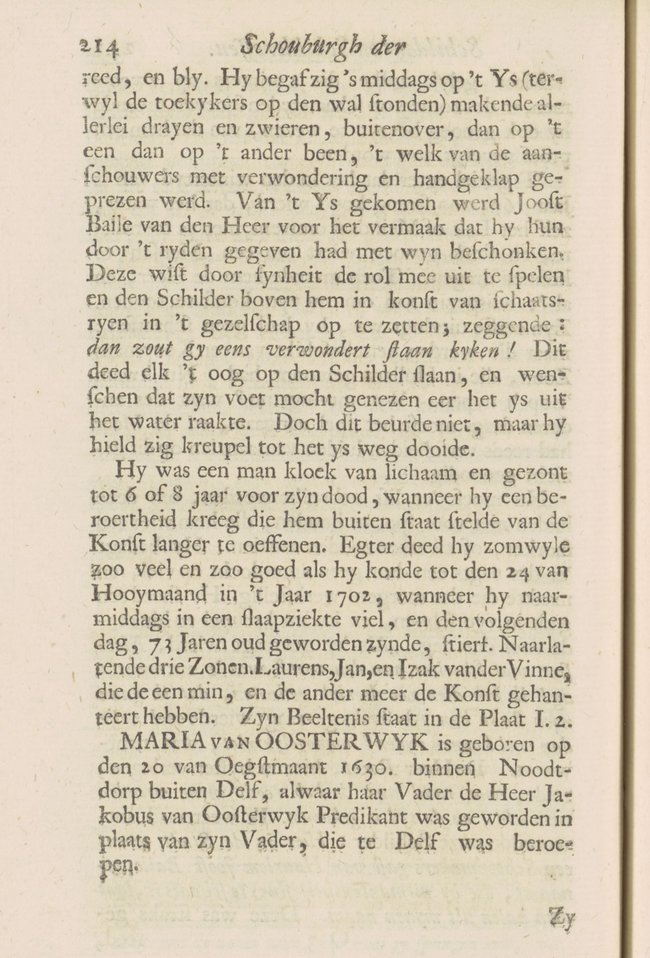
Page 215
From her youth onward she gave evidence of a great intellect and passion for painting and did not extinguish that powerfully radiating art flame by resisting it but, on the contrary, she fanned it by encouragement. Which is why, seeing that her inclination leaned to the painting of flowers and other still life, she picked out an esteemed and competent master for herself, namely the renowned flower painter Jan Davidsz. de Heem of Utrecht.
The virtue that she radiated will not permit that I resound the worth of her art with a protracted monotone, or drone forth her fame with a bent-trumpet tone;
Frustra fit per plura quod per pauciora fieri potest.
It is fruitless to express something in a great many words that can be said concisely.
Her way of painting was detailed, powerful and soft, or again quick, according to the subjects that she depicted, such as flowers which demand thinness and clarity if one wishes to imitate nature in her beauty. It was the glory of art that made her scenes so beloved that most courts in which the love of art dwells became enamoured of it. The art-supporting King Louis XIV placed one of her art scenes in his art cabinet. The Emperor Leopold I and his spouse placed one as well [1], which they appreciated so greatly that they sent her their portraits surrounded with diamonds as a present. King Willem III and Mary Stuart II also
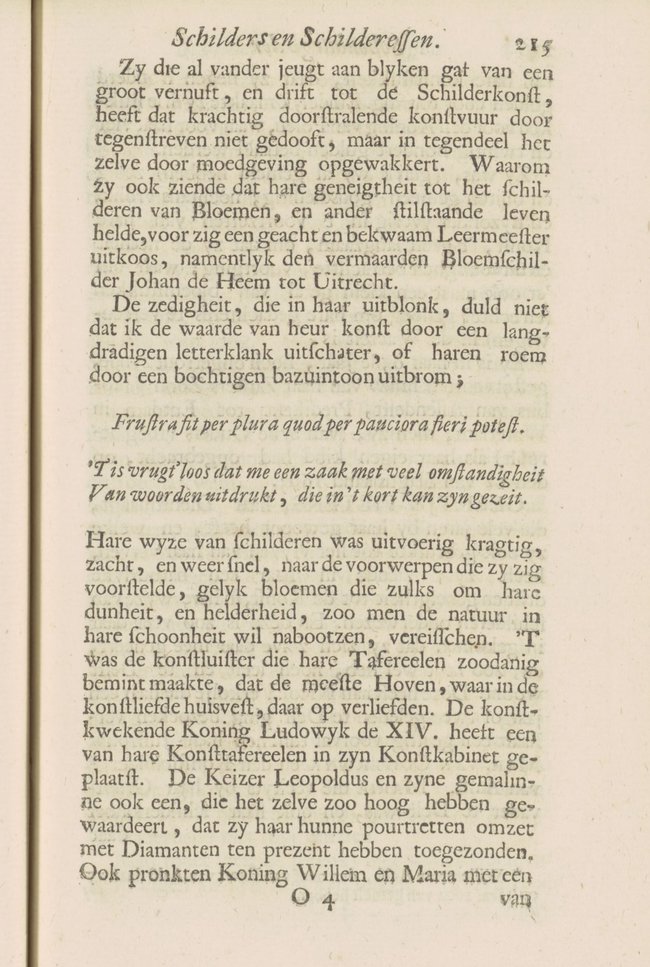

1
Maria van Oosterwijck
Vanitas Still-life with a skull, books, flowers in a vase and a celestial globe, dated 1668
Vienna, Kunsthistorisches Museum, inv./cat.nr. GG 5714
Page 216
displayed one of her art works, for which she received nine hundred guilders. Finally, she made three pieces for the King of Poland [=Jan III Sobieski], for which she was paid twenty-four hundred guilders.
She was (as we have already mentioned) modest and exceptionally religious, but nevertheless happy and unusually diligent in the pursuit of her art, which proceeded slowly because she pursued precision and detail, which is why there is only a small number of her flower pieces (though enough to make her memory immortal) in the world.
She died on the 12th of November 1693 in her 63rd year, still being unmarried, in the house of her sister's son Jacobus van Assendelft, a preacher in Uitdam in Waterland, whom (robbed early of his parents) she had raised as her own child.
Seeing her natural passion and inclination for art, she taught her maidservant GEERTGEN WYNTGES, who lived with her for years, in her way of painting and also used her for the grinding of her paints. And she got so far that she earned a living for herself and if I have it right is still alive and living in Delft. She told Nicolaas Verkolje, who went to visit her in Delft a year or two ago, an amusing incident between her mistress Maria van Oosterwijck and the painter Willem van Aelst.* Maria, who was often with her grandfather in Delft and also had her studio
--------
* Willem van Aelst, the nephew of Evert van Aelst, whom we mentioned for the year 1602.
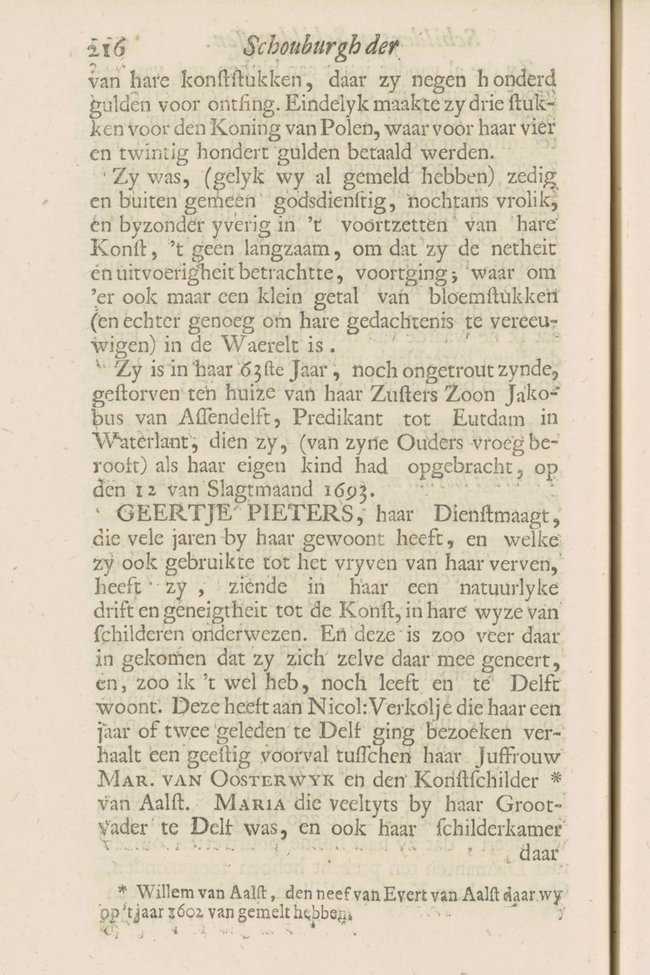
Part 217
there when pleased her to practice her art, was visited now and then by Willem Van Aelst, who desired to see the art of her brushwork. He finally also began to admire and court her. Although not inclined to marriage, Maria did not let this show, even less did she slap his face (as people say), but thought up an inventive stratagem by which his intentions were frustrated. She was of commendable composure, diligent and precise in the practice of art, and he a lax fellow and one who was often out having a good time. Thus she came to an agreement with him that all day for a whole year (except for some hours that he had insisted on for his recreation) he had to paint during certain precise hours and that she would then be prepared to talk to him to speak of courtship. But if he did not comply with this, she would be released from her given word and would have the right to reject him, as took place. Now it just happened that the back of the house in which Van Aelst lived adjoined that in which Maria lived, and that they could see each other and talk, so that she could always know if he was busy or not. And when at the allotted hour, in consequence of honouring the agreement, he did not answer when she called, she would enter a mark in chalk on the frame of her window. Van Aelst, who was able to guess that he would have more on his slate for that year than he could atone for with a bit of sweet talk, later stopped paying attention.
One must (goes the saying) not attempt to jump farther than one's pole can reach. It is the
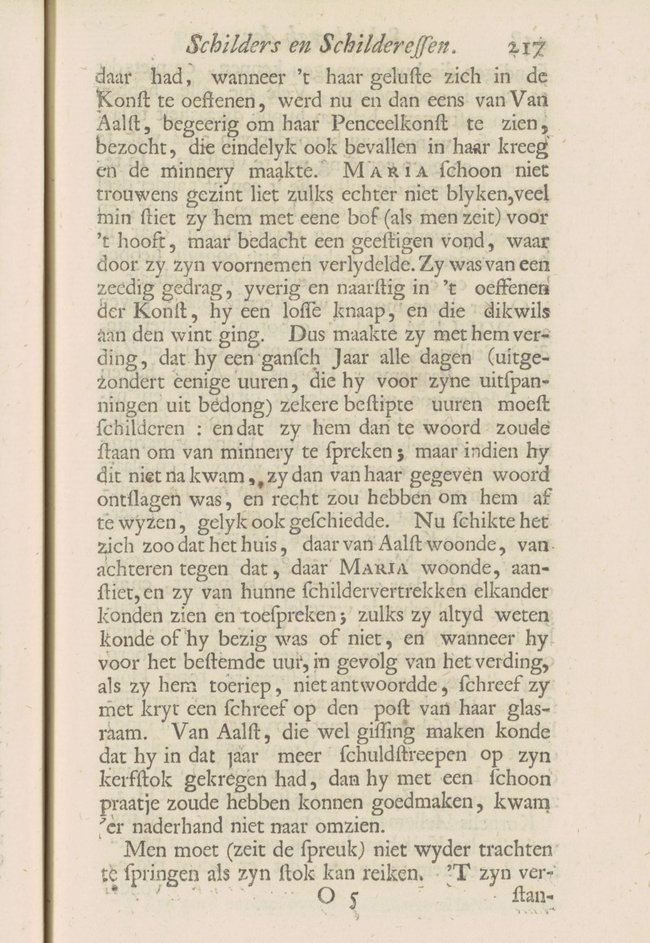
Page 218
wise who know their own limitations and attempt nothing too elevated. Many who have attempted to pursue everything have realized their folly too late, when they discovered they knew something about everything but nothing well. On the contrary, one sees that those who have focused on this or another part of art and attempted to excel above others in it, have reached their goal and imperishable fame.
Among these we must give pride of place to WILLEM KALF, born in Amsterdam, who was able to paint still life, and primarily gold and silverwork, mother-of-pearl, horn, and agate knife handles so wonderfully well and naturally that (though paintings of such preferences are now little valued, having had to surrender space for more worthy subjects) his works remain highly esteemed by all connoisseurs. His instructor in art was Hendrik Pot.
He was a well-read man, with good judgment. In addition he was so eloquent and specialized in all sorts of tales that everyone found pleasure in his company. Once in a while he chained them with their ears to his eloquent tongue with these tales for a night at the inn. In addition he was exceptionally ready to be of service to everyone (even if it harmed himself), so that his wife [= Cornelia Pluvier], often said that he looked more to another's advantage than to his own. His portrait is found in Plate H. 2.
Cornelis Hellemans, art seller, has told me that Kalf had requested him to engage in commerce in prints with him, that at that time
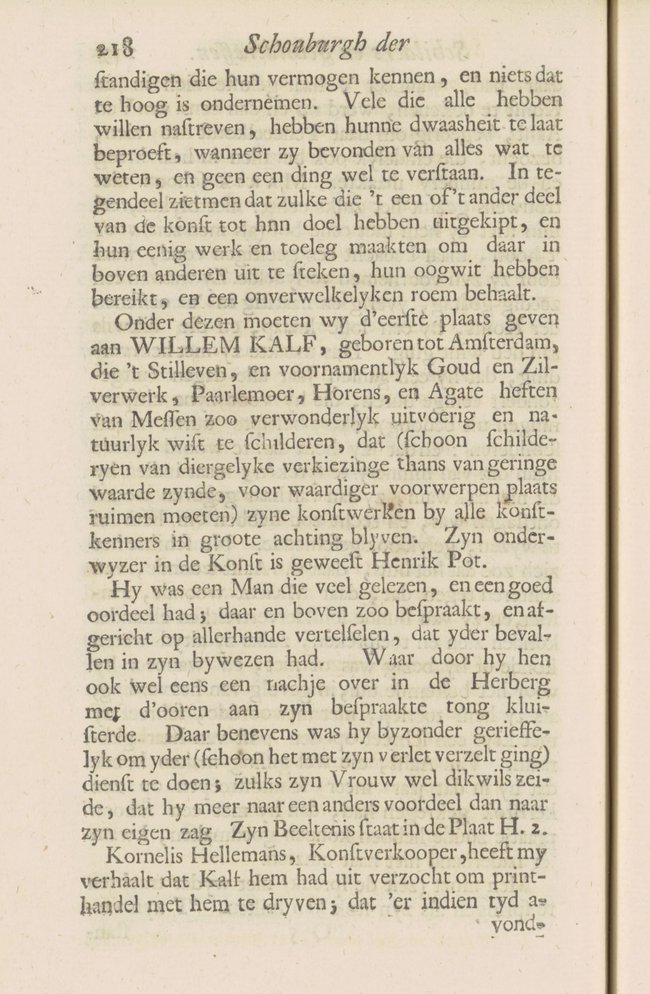
Page 219
there were public prayer meetings convened in the evenings, and that he used this time from five to seven, closed his shop, went to him and did business with him, on the agreement that Kalf would drop by for his money on another day. But whoever showed up, not Kalf, for whom he waited from day to day until he received a funeral notice, from which he saw that he had died the same night that he had been with him, which upset Cornelis more than a little.
He had been ill sometime previously, but had recovered. He had been at a sale of paintings in the gentlemen's inn that day and in the evening at about half past eight, still at the house of Jan Pietersz. Zomer, he went home, tripped on the Bantammer bridge, and fell forward on his chest. He did feel pain, but not reflecting on any consequences, went to bed and was a corpse by the time the clock had struck ten. This happened on the 31st of July 1693. Willem van der Hoeven composed the following epitaph in his memory:
Approach this threshold respectfully,
Oh painter-spirit, intent on art,
Know that a worthy body rests here,
The beacon of painters,* mark and stamp
Of the outstanding Wilhelm, who knew how
To paint the treasure of Croesus wonderfully well,
Not to be remunerated even with that treasure
As he never knew his equal.
Help celebrate the memory of this Phoenix,
Garnish his maulstick and brushes with laurels
--------
* His good judgment about the art of painting in general.
